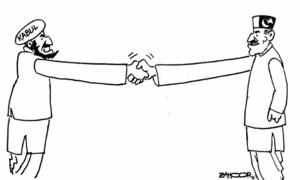IT was on Ashura, Aug 19, 2021, when nine-year-old Priya Kumari went missing. Just before her disappearance or abduction she had been happily helping her father — a syncretic Hindu who runs a sabeel every year in Muharram in Sangrar, a small town near Sukkur — serve sherbet to thirsty mourners. It is a curious case. For one, she ‘disappeared’ from a place that was thronged with hundreds of people, and yet, reportedly, the police found little by way of evidence or even a witness. And for another, her tragedy touches upon every element that has rent apart society, ie, faith, gender, class, and abuse.
Faith: Priya, a Hindu girl, was targeted when she was engaged in religio-cultural services for Muslims. She symbolised a tolerant tradition that goes back centuries, ie, peaceful cohabitation of various communities in Sindh, and beyond. In defiance of an obscurantist mindset that has spawned violence against religious minorities, she and her father transcended faith-driven fault lines. Her victimhood, therefore, not only exposes a corroded criminal justice system, but goes deeper into the conceptual recesses of a state caught between two conflicting philosophies. The state can either be viewed in terms of a benevolent democracy that accords equality before the law, and grants freedom of worship to every citizen, regardless of colour or creed. Or it can be seen as an ideological tool cast in the mould of a particular policy strand. Priya and many other individuals, groups and communities come under the latter.
Gender: Priya’s tragedy shows the threat to ‘gender justice’, which envisages the systemic removal of inequalities between men and women in both law and practice. She is among the countless children and women who are targeted for their gender, in different forms and to varying degrees. Thus, many of the better educated and more aware urban women are less vulnerable to extreme forms of gender crimes, though they may also face incidents of violence, abuse, or harassment. But the hotbeds of gender-based crimes are largely located in the rural and tribal areas where a combination of feudal, tribal, and obscurantist elements continue to regulate rural life, aided by an ineffectual or complicit state machinery.
Even here, the ratio of gender-based crimes — forced marriages, ‘honour’ killing, domestic violence, kidnapping for ransom, etc — is relatively higher among the half-literate and poorer sections. Clearly, the state has been criminally negligent in enforcing the rights of these hapless women — largely on account of the substantial influence that the local feudal-tribal patriarchy exercises over social policy and governance. But can the state flout local and international laws — particularly the Convention on the Elimination of All Forms of Discrimination Against Women that obligates states to protect women’s rights — just to appease its local surrogates?
The missing young girl’s tragedy can be seen from the lens of multiple societal factors.
Class: Priya’s plight also highlights the social angle of crimes against women. She comes from a poor family and is possessed of all the vulnerabilities that accompany indigence and disempowerment. Statistically, a majority of sexually victimised children come from poorer and underprivileged classes. Perhaps the offenders are emboldened both by the victim’s incapacity to bring them to justice, and the state’s routinely tepid response. As a result, these ‘ordinary’ cases are left undetected, or invariably ‘settled’.
Recently, we saw two instances of our lame-duck criminal justice system. In 2021, Nazim Jokhio, a wildlife activist, was brutally murdered near Thatta when he tried to stop the hunting of protected birds. His was, as they say, an open-and-shut case. But the powerful offenders were ‘pardoned’ by the victim’s family out of desperation and helplessness. In August last year, Fatima Fariro, a nine-year-old maid, died in mysterious circumstances in Ranipur, located near Khairpur. The investigation report (including the video footage of the crime scene) has attributed the cause of her death to the abuse and torture allegedly committed by her employer, an influential pir. But the prosecution remains to be concluded, despite the lapse of many months. It is feared that the delay, even if not intentional, will be used to settle the matter out of court.
Abuse: Priya’s case pertains to ‘disappearance’ or ‘abduction’, but abuse cannot be excluded. Child abuse is on the rise. Of the 2,227 abuse victims reported in 2023, more than half (54 per cent) were girls. Let’s not forget that children, like women, enjoy multiple protections under general, special, and international laws. The UN Convention on the Rights of the Child, in particular requires the state to ensure the civil, political, economic, social, health and cultural rights of children. But it is unfortunate that child abuse, like forced disappearances, is rampant and neglected — more so if the victim comes from a poorer background. In fact, most successfully prosecuted cases are those vigorously pursued by the victim’s family; otherwise, they end up in the amnesiac entrails of our criminal justice system.
Priya is lucky that the media, civil society and political activists have kept her case alive. Recently, the government constituted another JIT under public pressure. But will the new JIT bear fruit in terms of recovering her and ensuring justice for her? The answer hinges on many variables, including the victim-family’s perseverance, the investigator’s diligence, the suspect’s clout, the prosecutors’ capacity, and more importantly, the court’s willingness to decide the matter expeditiously and justly.
In a curious way, Priya’s unexplained disappearance, Fatima’s unending prosecution, and the ‘pardoning’ of offenders by Nazim’s family reflect respectively the incapacity, dysfunctionality, and discomfiture of the entire criminal justice system — the law, police, investigation, prosecution, and adjudication. Ergo, a perception is gaining ground that our legal order has lost its effectiveness, hence, legitimacy. Desperate people are taking the law into their own hands. ‘Mob justice’ and vigilantism are on the rise. Which raises the critical question: can a state see stability and advancement without an effective and legitimate legal order?
The writer is a lawyer and an academic.
Published in Dawn, April 18th, 2024












































